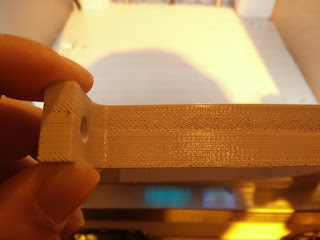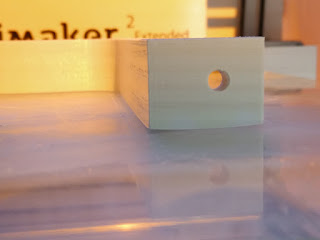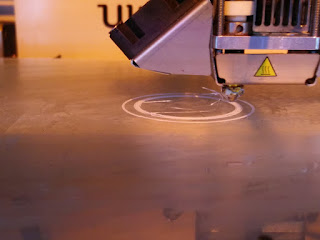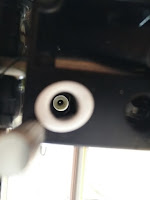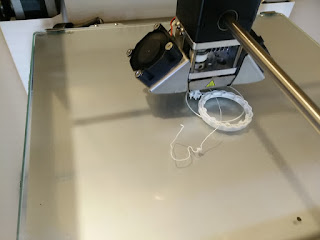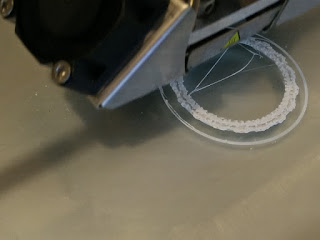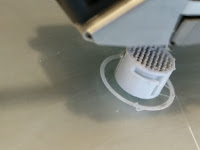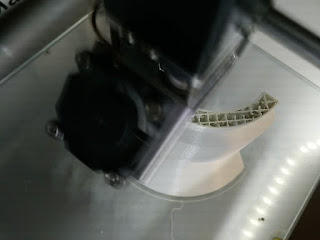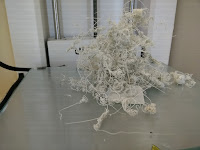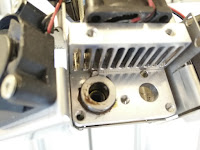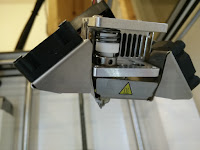- I'm currently on the 32C3 congress, testing Colorfabb nGen filament (Amphora AM3000) on my Ultimaker II extended using an Olsson block with a 0.4mm brass nozzle.
work in progress....
I solved some issues with:
- first layer adhesion to the glass bed
- unexplainable underextrusion
- warping
See the bottom of this posting for an Ultimaker .ini file for this material and the preliminary conclusions I draw from the tests described here.
test cases
nozzle cleaning
A Cold Pull/Atomic cleaning doesn't seem to work anymore.Below 100 degrees it's impossible to remove by hand and
above its not pulling out anything but stretching like bubblegum.
I need to find a temperature that works for a cold pull to have repeatable test-conditions...
at 240°C
There seems to be a recurring underextrusion issue.
All test-parts are brittle. A part that would be strong in PLA/PHA I I can now crush with 2 fingers in nGen. (1cm thick, 20% infill, 3 solid layers)
After I temporarily fixed the underextrusion by changing to another new nozzle (as a cold pull doesn't work), I noticed very heavy warping.
These are the settings:
I printed with and without a front door present on the UM2extended.
- 240°C Nozzle
- 85°C well leveled glass Bed with glue stick
- 4.5mm retraction at 45mm/s
- fans at 50%
- 0.1mm layer height (Cura "normal" profile)
- 0.8mm walls (Cura "normal" profile)
- 0.6mm tops/bottoms (Cura "normal" profile)
- 60mm/s (Cura "normal" profile)
- 5s minimum layer time (Cura "normal" profile)
at 220°C
I'm currently doing a comparison print in 220°C/75°C with the speed reduced from 60mm/s to 40mm/s as suggested on the "recommed settings" page below.
The part simply doesn't stick to the glass surface at all with or without using a glue stick.
at 220°C with a very hot bed
- Still at 40mm/s. Let's try the lower printing temperature with a very hot bed, to make it stick...
- It doesn't stick as well as 240°C+85°C but better then 220°C+75°C. It seems to actually get a first layer down. ...some of the times.
- It still doesn't still every time. Even with a fresh layer of glue-stick.
I have the impression that the issues are getting worse since I can't clean the nozzle via a cold pull.
nozzle cleaning using PLA
32C3 is over and the printer is now placed in a private home.Based on some feedack on Google+, I just cleaned the nozzle using some PLA/PHA (my usual melt at 220°C, then pull at 70°C). As the melting points are so similar, this worked well. I also cleaned the bed from excess glue-stick using a wet paper towel.
I'm attempting another nGen print at 230°C + 85°C now in this new environment.
Fan still at 50%, no front door.
First layer sticks well, no signs of any problems yet.....still printing.
The part did come loose from the cleaned glass. It is however strong and shows no signs of underextrusion.
I'm trying again using 220°C/75°C after some fresh glue-stick. (no intermediate nozzle-cleaning)
Some signs of underextrusion. Aborted to do another cold-pull cleaning using PLA. I did not push until only black PLA exited the nozzle.
Printing again (230°C/85°C fresh glue stick applied after heating up)...
...Severe underextrusion.
Cold-Pulling PLA again. This time pushing until there is no more white nGen.
I'm thinking of exchanging the expensive Teflon-inset in the Ultimaker II hotend.
(230°C/85°C/130% feed rate/fresh glue stick applied after heating up)
Despite 130% material flow and a perfectly clean nozzle, still underextrusion.
the PTFE liner
I took apart my hotend and replaced the PTFE liner. This part needs to be replaced regularly with any kind of filament. Aparently mine was at the end of it's life. (My failed attempts to cold-pull nGen with nGen surely didn't help.) Surely this has caused at least some of the issues.
Sadly Ultimaker sells this part for 15eur + 20% VAT + 20eur shipping=38eur. Currently the ship sends you to end endless loop of selecting a reseller where you can only select Ultimaker itself to be sent to select a reseller....
This was my last spare one.
You can get them in China but they are probably not glassfiber-reinforced as Ultimaker claims their ones to be. Beware that at least one dealer there seems to oversize them (3.2 instead of 3.0mm on the inside and +0.1mm on the outside.)
Printed again (230°C/85°C/back to 100% feed rate)
Not perfect but not far from it either.
Cura infill speed
Objects with thicker infill have underextrusion in the infill. I forgot the fact, that Cura by default prints infill MUCH faster (80mm/s). Way outside the speed these settings are recommed for.
Since I can't change that mid-print, the photo shows layers where I manually adjusted the flow rate to 110% to compensate and not loose this part.
bridging
I accidentally did some extrusion into mid-air and the nGen handled that surprisingly well.
wear and tear
...now doing more testing to compare it's reliability to PLA/PHA.
I started to have underextrusion issues again. These are 2 out of 5 attempts. The others had walls you could shine light through or break with 2 fingers. Could it be that the PTFE liner didn't last for more then 5 prints? Everything else seems to be accounted for (cold pulled, bed cleaned and glue stick re-applied, no moving air in the closed room, bed leveled, correct nozzle diameter, no dust).
I'm currently trying to reduce speed by -20% to see if less pressure helps as I don't have yet another 40eur PTFE liner and receiving UPS shipments in this private home address doesn't work (I have to work during office hours because these are...office hours).
I checked the PTFE liner and, while it didn't show much wear, it did have a grove on the inside.
Luckily I still had 2 of the expensive hotend-kits. Both are no longer of any use after the Olsson Block upgrade. So I took yet another PTFE liner from there. ..this is getting real expensive.
I'm testing some lower temperature, slower settings from the recommed ones.
At 75°C hopefully the glue stick won't evaporate as quickly and at 220°C the PTFE liner may hold up better.(I'm printing a spring replacement, so the PTFE-liner is not pulled up during a cold-pull.)
[material]
name=NGen
temperature=220
bed_temperature=75
infill_speed = 40
print_speed = 40
fan_speed = 50
fan_speed_max = 50
flow=100
retraction_speed = 45.0
retraction_amount = 4.5
diameter=2.85
(Note: Inner walls are still too fast with these settings)Experiment:
- be more careful in cold-pulling (the PTFE liners are getting real expensive here)
- use wood glue with water insted of glue sticks. It is sticky and stays sticky when the water evaporates.
- use colder temperatures and lower speeds.
- With the lower temperaturs it sticks to the print bed even worse.
- wood glue doesn't work.
Cleaned, new PTFE liner, spring replaced.... this 18 hours later. (This object must be strong to perform it's function. It has 35% infill and 1.2mm walls for that purpose.)
I fear my reliability-test of Colorfabb nGen filament has failed completely.
repairs
Due to feedback as to the size of the spring-replacement, I found out that my Olsson block was not perfectly installed.This may or may not have any inpact. The machine has been taken apart, the spring is installed again, the Olsson block is 3mm deeper, so is the nozzle, the heater cartridge is sanded down and inserted deeper, heat sensor is still sticking out by 2mm as before, everything is cleaned again and currently printing a small 10h job at 230°C/85°C and 60mm/s. It starts of perfectly but real results as to the reliability won't come until it has completed 5-10 real world prints.
preliminary conclusions
ngen.ini
(this is the content of an ngen.ini file that you can import into an Ultimaker II)[material]
name=NGen
temperature=230
bed_temperature=85
fan_speed=50
flow=100
diameter=2.85
infill_speed = 0
preliminary findings
- Cold pull of nGen doesn't work (yet). Clean the nozzle using a cold-pull with PLA!
- Push until PLA exits the nozzle. nGen doesn't seem to stick to PLA/PHA.
- Beware of your PTFE liner. Don't go below 70°C to not damage it and/or replace your spring with a printed tube that doesn't give in when pulling.
- Clean glass doesn't stick. Use glue-stick as with PLA!
- beware. Glue stick doesn't like high tempearatures. It evaporated quickly and isn't sticky anymore. So apply it after the hot end has heated up and moved upards but before the print starts.
- At 220/75°C it doesn't stick to anything well. At 230/85°C this completely goes away.
- The surface needs to be sticky. Not just rough as with PLA. So glue-stick must be fresh.
- Warping! Avoid low tempeatures in the build volume. 85°C bed, no drafts from an air conditioning. A front door is not required.
- Obviously keep the bed leveled and cleaned of excess glue-stick.
- It may be requied to clean the nozzle very often. This is a good idea anyway.
- Chek your Cura settings for infill-speed. By default in "normal" profile it's 80mm/s while these are recommed settings for just 60mm/s. I got underextrusion in the infill but not in the 30mm/s(outher)+60mm/s(inner) surface layers.
Links
- nGen
- Eastman Amphora AM3300 data sheet
- recommed settings
- In the comments someone else seems to have similar issues.
- German forum thread
- Colorfabb suggesting to contact them
- Ticket 3142 (Ticket system broken. Uses an SSL certificate that doesn't belong to that domain.)
- Spring replacement
- PTFE-Liner
- China Copy

